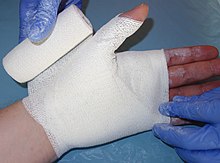Zinc glue bandage
The zinc glue bandage is a bandage method that is mainly used in orthopedics and sports medicine , but also in compression therapy and can be used to reduce or prevent swelling, as well as to support or stabilize injured limbs .
application
The zinc glue is a paste made from zinc oxide , binder and water. Bandages soaked with it are wrapped around an injured, swollen or threatened extremity . The industry offers elastic gauze bandages as a carrier material. Some doctors prefer the inelastic zinc paste bandages. The technique of applying such a bandage is more complex, but it is more precise to dose the compression exerted with it. A zinc glue bandage creates a compression effect while at the same time cooling the bandaged area of the body. It is therefore used on swollen parts of the body or areas that threaten to swell. Other areas of application are the stabilization of the limbs in the case of bursitis or tendinitis . The zinc paste bandage also postoperatively for use, but also with fractures of the fibula without deformity initially wound. This dressing can also be used for stabilization, for example in the case of distortions ; however, the easier-to-use tape dressings also have a stabilizing effect.
Compression therapy
Edema caused by injuries or disorders of the venous function can be treated with bandages made of zinc paste, which offer a high resistance to muscle movement, the so-called "working pressure". When using zinc glue bandages in compression therapy , the zinc glue bandage is usually applied with the help of a tricot tube . This limits the maximum volume that the swelling can assume. After a few days, the bandage is loose and needs to be replaced. In this way you can gradually reduce the swelling, after which the normal metabolism usually starts again in the tissue.
The principle of the zinc glue bandage for compression therapy was developed at the end of the 19th century by the Hamburg dermatologist Paul Gerson Unna . Nowadays they have lost their place in the first phase of compression therapy, in which patients are usually provided with special disposable binding systems, short-stretch bandages or adaptive compression bandages . In the English-speaking world , however, these associations are still widespread and are still referred to as Unna-Boot or Unna's boot , referring to Paul Gerson Unna .
Web links
- Yasmin Hailer: Zinc glue bandage. In: Engelhardt Lexicon Orthopedics and Trauma Surgery. Retrieved September 9, 2014 .
- Zinc glue bandage knee - mode of action, instructions & tips. Med-Library.com, November 13, 2013, accessed September 9, 2014 .
Individual evidence
- ↑ Stephanie Reich-Schupke, Markus Stücker: Modern compression therapy . A practical guide , Viavital Verlag, Cologne 2013, ISBN 978-3-934371-50-7 , page 105 - page 106
